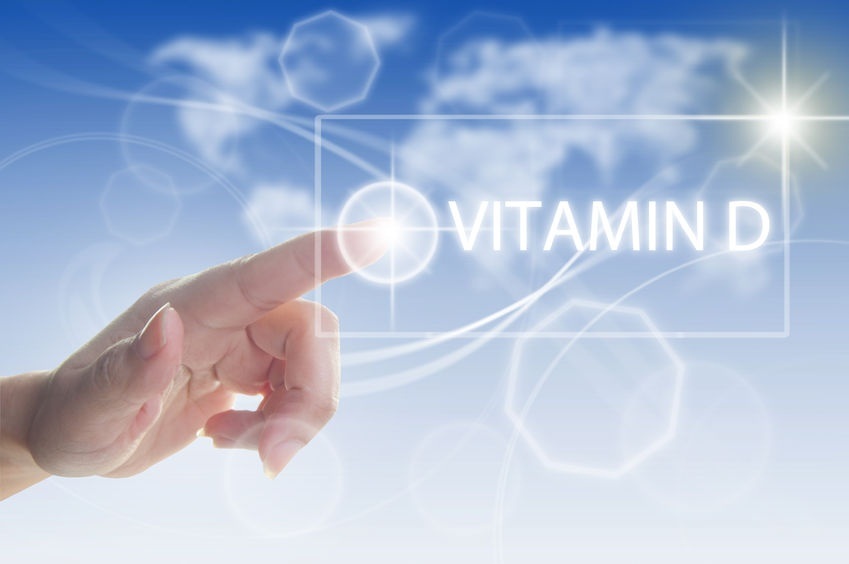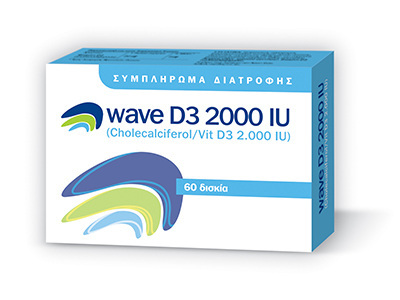Items list

What is wave D3 2000 IU?
Wave D3 2000 IU is a high-quality preparation recommended for supplementation by people wishing to take care of their immune system and good health. The preparation is also recommended in the autumn-winter weather, as well as for people with deficiency of vitamin D3 in the diet.

Vitamin D3 is produced by the effect of ultraviolet radiation on the skin. Although any organism can produce vitamin D3, the modern lifestyle and insufficient exposure to sunlight, results in vitamin D3 deficiency, which must be obtained through food, as its role in maintaining it organism in good condition is important.
It should be emphasized here that when we refer to Vitamin D we mean a set of many chemically similar substances without always biological activity and their measurement has a specific meaning and is evaluated by experts when it is to administer a metabolite. In humans, the most important compounds in this group are vitamin D3 (also known as cholecalciferol) and vitamin D2 (ergocalciferol).
The major natural source of the vitamin is synthesis of cholecalciferol in the lower layers of skin epidermis through a chemical reaction that is dependent on sun exposure (specifically UVB radiation). Cholecalciferol and ergocalciferol can be ingested from the diet and from supplements. Only a few foods, such as the flesh of fatty fish, naturally contain significant amounts of vitamin D. In the U.S. and other countries, cow's milk and plant-derived milk substitutes are fortified with vitamin D, as are many breakfast cereals. Mushrooms exposed to ultraviolet light contribute useful amounts of vitamin D. Dietary recommendations typically assume that all of a person's vitamin D is taken by mouth, as sun exposure in the population is variable and recommendations about the amount of sun exposure that is safe are uncertain in view of the skin cancer risk.
Vitamin D from the diet, or from skin synthesis, is biologically inactive. It is activated by two protein enzyme hydroxylation steps, the first in the liver and the second in the kidneys. As vitamin D can be synthesized in adequate amounts by most mammals if exposed to sufficient sunlight, it is not essential, so technically not a vitamin. Instead it can be considered a hormone, with activation of the vitamin D pro-hormone resulting in the active form, calcitriol, which then produces effects via a nuclear receptor in multiple locations.
Cholecalciferol is converted in the liver to calcifediol (25-hydroxycholecalciferol); ergocalciferol is converted to 25-hydroxyergocalciferol. These two vitamin D metabolites (called 25-hydroxyvitamin D or 25(OH)D) are measured in serum to determine a person's vitamin D status. Calcifediol is further hydroxylated by the kidneys to form calcitriol (also known as 1,25-dihydroxycholecalciferol), the biologically active form of vitamin D.
 Active Ingredients
Active Ingredients
Each wave D3 2000 IU tablet contains: 50μg (2000IU) of vitamin D3 (cholecalciferol).
 Recommended dosage
Recommended dosage
1 wave D3 2000 IU tablet per day, preferably after a meal.
 Actions of wave D3 2000 IU
Actions of wave D3 2000 IU
- It plays an essential role in maintaining the homeostasis of calcium and phosphorus
- Contributes to the normal absorption of calcium and phosphorus
- Helps maintain healthy bones and teeth
- Its presence in sufficient quantities, is essential as it is involved in tissue metabolism and for the differentiation of cells and the maintenance of membrane function, as well as for the function of various organs such as skin, muscles, pancreas, nerves , the parathyroid gland and the immune system
The advice of a doctor is required if the user is pregnant, breast-feeding or on medication or has health problems.
 FAQs
FAQs
How much VitD3 do I need?
To get the benefits of vitamin D, we need to maintain blood levels above 50 ng / dl throughout the year.
Can its administration, in increased doses, cause toxicity?
The answer is that in theory this can happen, but in practice it is impossible. Isolated cases are reported in the literature where huge amounts of vitamin D3 were mistakenly obtained, such as 2,400,000 or 1,680,000 IU of vitamin D3 per day (4). Symptoms of vitamin D3 toxicity, such as cramps, nausea and dizziness, occurred after receiving these doses for 5 months. To receive this dose of vitamin D3. one must consume more than 800 capsules of 2,000 IU per day, which is practically impossible.
Has Vitamin D3 an effect on calcium levels?
One of the common concerns of physicians and pharmacists regarding the intake of high doses of vitamin D3 is the manifestation of toxicity through increased blood calcium levels .
From the review of studies in the subject, there is no case of toxic levels of calcium for levels of vitamin D - in its natural form (25OHD3) - in the blood up to seven times above normal (700 ng/dl), normal levels are up to 100 ng/dl.
What is the recommended maximum safe doses?
The recommended maximum safe doses, according to the American Society of Endocrinology, without monitoring and measuring its levels by a doctor, are 10,000 IU per day for adults and 4,000 IU for children aged 8-18. Doses higher than 10,000 IU per day, in order to restore a significant deficiency of vitamin D, should be done under the supervision of a doctor and measuring its levels in the blood.
The above doses are completely normal and expected, since the human body after sun exposure, in summer, produces 10-20,000 IU of vitamin D3, in about 15 minutes. Doses of 5-10,000 IU per day, for adults, are the minimum to achieve a competent biological result. According to Robert Heany, professor of endocrinology and world leader in vitamin D research, no case of toxicity has been reported in the literature, up to a daily dose of 30,000 IU of vitamin D3 per day and levels up to 200 ng/dl in the blood for long periods of time.
Recent data suggest that vitamin D3 is safe at doses much higher than previously considered safe.
 Bibliography
Bibliography
1. Changing Incidence of Serum 25-Hydroxyvitamin D Values Above 50 ng/mL: A 10-Year Population-Based Study Daniel V. Dudenkov, MD et. al. Mayo Clinic Proceedings
2. Vitamin D in Health and Disease Robert P. Heaney Creighton University.
Clin J Am Soc Nephrol 3: 1535–1541, 2008.
3. Evidence that Vitamin D Supplementation Could Reduce Risk of Influenza and COVID-19 Infections and Deaths by William B. Grant et. all.
https://www.mdpi.com/2072-6643/12/4/988/htm
4. Risk assessment for vitamin D. John N Hathcock, Andrew Shao, Reinhold Vieth, and Robert Heaney. Am J Clin Nutr 2007;85:6–18
5. Vitamin D Is Not as Toxic as Was Once Thought: A Historical and an Up-to-Date Perspective Michael F. Holick, PhD, MD Mayo Clinic Proceedings. DOI:
https://doi.org/10.1016/j.mayocp.2015.03.015
6. Evaluation, Treatment, and Prevention of Vitamin D Deficiency: J Clin Endocrinol Metab, July 2011, 96(7)1911–1930










